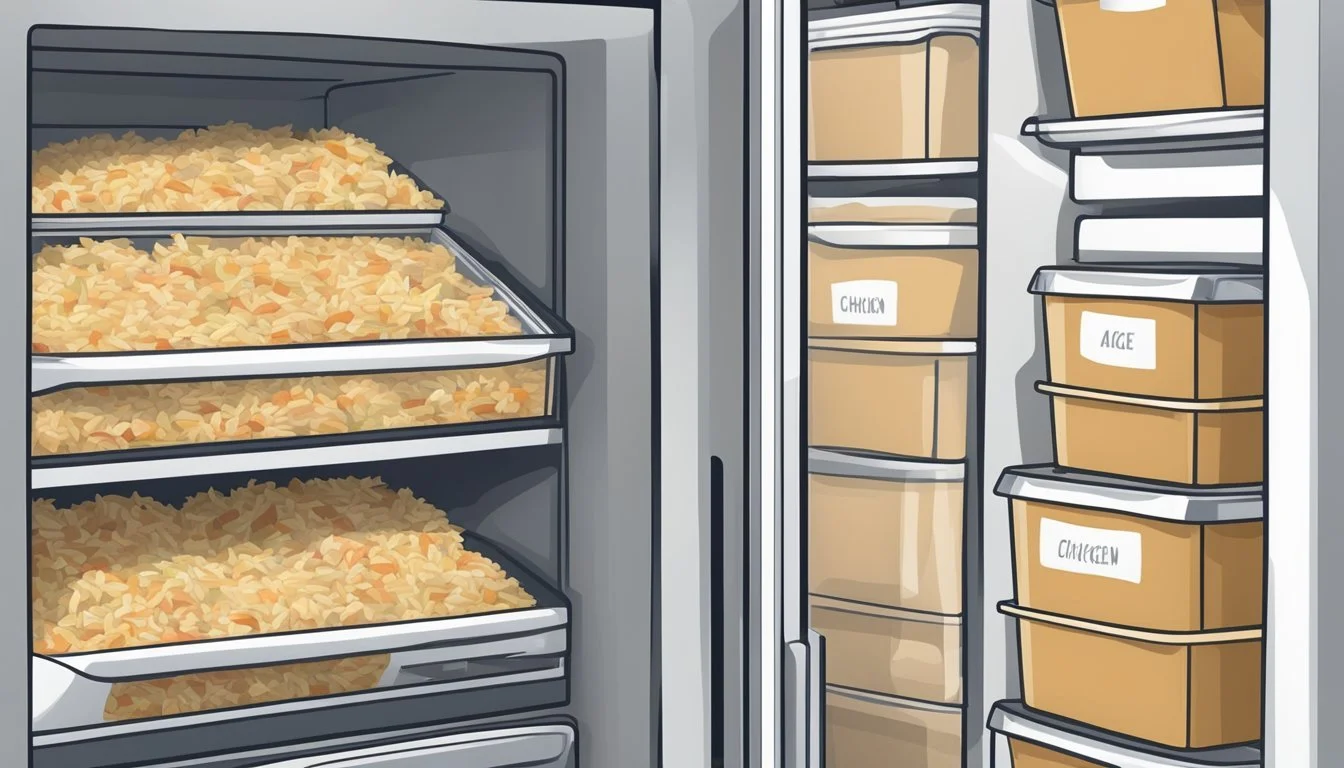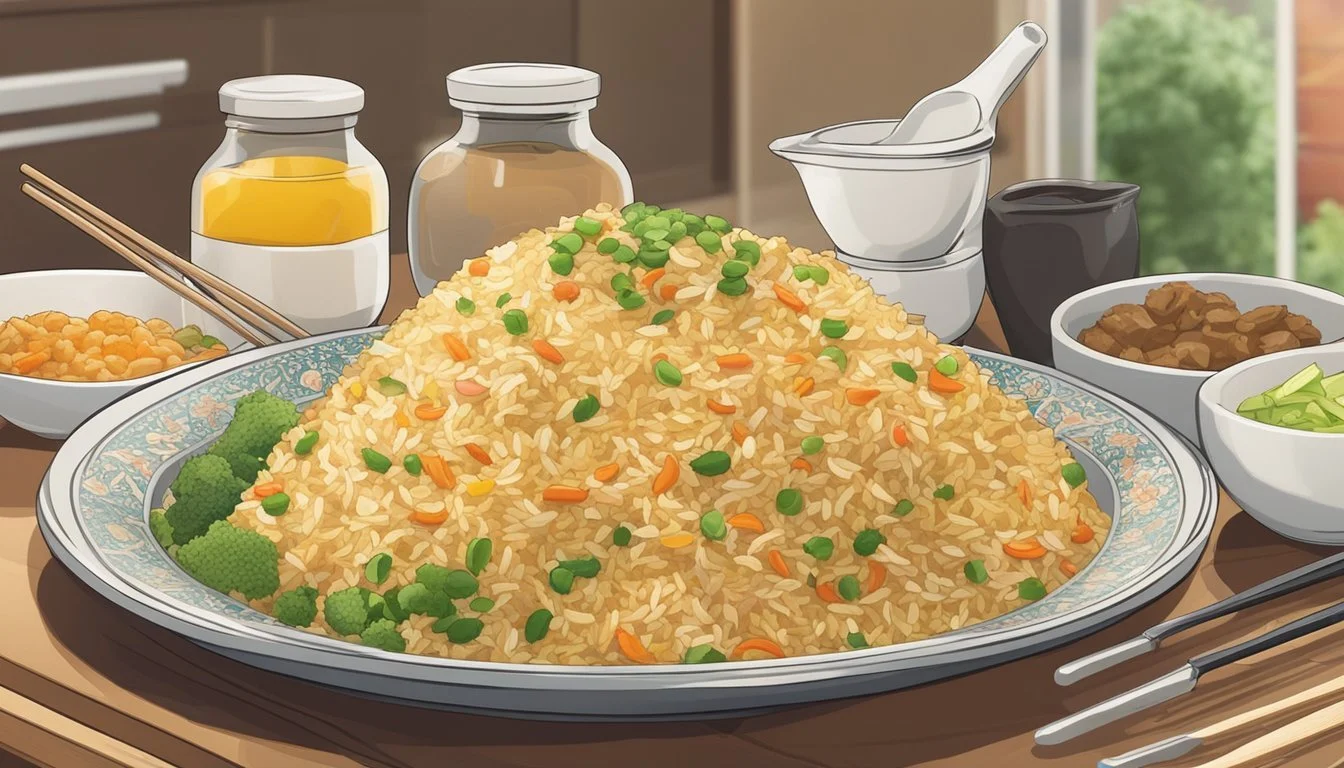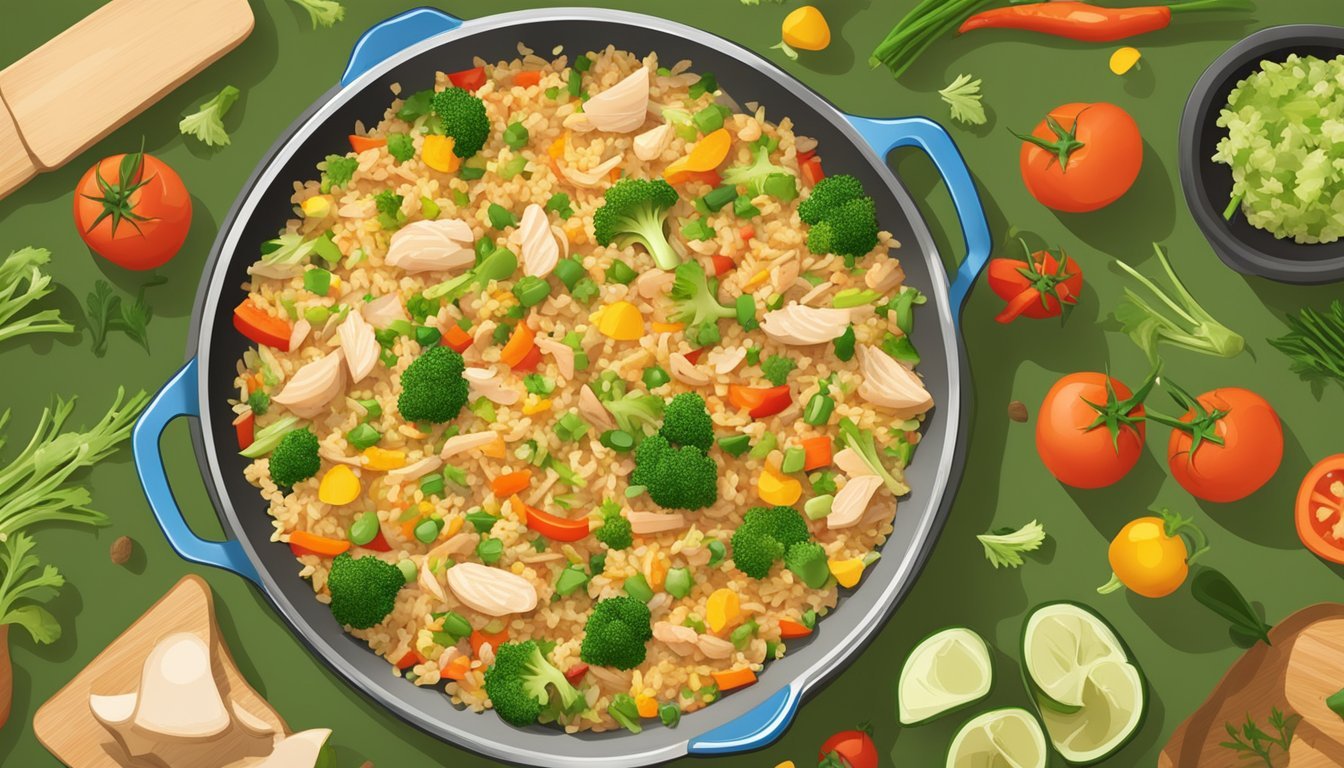How Long Does Chicken Fried Rice Last?
Storage Tips and Guidelines
Chicken fried rice is a favorite dish for many due to its savory taste and versatility. This meal, when properly stored, can remain safe to eat for several days. Chicken fried rice can last in the fridge for up to 4-6 days, depending on how it was prepared and stored.
Proper storage involves using airtight containers, which help maintain the freshness and safety of the dish. Ensuring the chicken fried rice is refrigerated promptly can further extend its shelf life. This makes it a convenient option for meal prepping and enjoying later in the week.
For those looking to keep chicken fried rice even longer, freezing is a viable option. By placing the meal in airtight containers or heavy-duty freezer bags, it is possible to extend its edibility beyond the initial few days, offering a ready-to-eat solution whenever hunger strikes.
Understanding Food Safety and Storage
Ensuring the safety and longevity of chicken fried rice involves knowing how to prevent foodborne illnesses and storing leftovers properly. Key factors include monitoring temperature, adhering to recommended storage durations, and avoiding contamination.
The Basics of Foodborne Illness
Foodborne illnesses can occur when food is contaminated with harmful bacteria, viruses, or parasites. Chicken fried rice is perishable and can harbor bacteria like Bacillus cereus, which thrives if food is left at room temperature too long.
The "danger zone" for bacterial growth is between 40°F (4°C) and 140°F (60°C). Within this range, bacteria multiply rapidly, increasing the risk of illness. Cross-contamination—when bacteria transfer from one food to another—should be avoided by using separate utensils and surfaces for different foods.
Optimal Storage Conditions for Leftovers
Leftovers, including chicken fried rice, should be stored in airtight containers to prevent contamination. Refrigerate these containers promptly, ideally within two hours of cooking.
Maintain refrigerator temperatures below 40°F (4°C) to slow bacterial growth. Chicken fried rice generally lasts 4 to 5 days in the fridge, but always check for signs of spoilage before consuming. Consider using the FoodKeeper app or guidelines from foodsafety.gov for specific storage advice. Freezing fried rice at 0°F (-18°C) can extend its shelf life further, keeping it safe for months.
Chicken Fried Rice: A Profile
Chicken fried rice is a beloved dish in many households and restaurants. It combines the simplicity of rice with the flavors of chicken and fresh vegetables. Proper preparation and the use of quality ingredients are essential for creating a delicious and healthy meal.
Composition and Ingredients
Chicken fried rice typically includes several key components: rice, chicken, vegetables, and various seasonings. Rice is often best when it's leftover, as slightly dried grains will fry better.
Chicken is usually cooked prior to mixing with the rice and can range from marinated, seasoned chunks to shredded pieces. Vegetables like peas, carrots, and scallions add both color and nutrition.
Common seasonings include soy sauce, garlic, and sometimes oyster sauce, which lend the dish its characteristic taste. This combination makes chicken fried rice a versatile and satisfying option.
Shelf Life of Chicken Fried Rice
Chicken fried rice requires proper storage to maximize its shelf life and ensure food safety. The shelf life depends largely on the storage method, whether at room temperature, in the refrigerator, or in the freezer. Each method affects how long the dish remains safe to eat.
At Room Temperature
Chicken fried rice should not be left at room temperature for more than 2 hours. After this period, bacteria can multiply rapidly, increasing the risk of foodborne illness.
Key points to remember:
Max Duration: 2 hours
Risk: High bacterial growth
Recommendation: Store in refrigerator or freezer promptly
Refrigerated Conditions
When stored in the refrigerator, chicken fried rice can last for up to 4-6 days. It is crucial to place the rice in an airtight container to prevent moisture and bacteria from affecting the food quality.
Key points to ensure longer shelf life in the fridge:
Max Duration: 4-6 days
Storage: Airtight container
Condition: Refrigerated promptly after cooking
Freezing and Frozen Storage
Freezing chicken fried rice significantly extends its shelf life, allowing it to last for up to 1-2 months. To freeze, place the rice in heavy-duty freezer bags or airtight containers. Thawing should be done in the refrigerator overnight for best results.
Key points for optimal frozen storage:
Max Duration: 1-2 months
Storage: Heavy-duty freezer bags or airtight containers
Thawing Method: Refrigerator overnight
Prioritize proper storage to ensure safety and maintain the best possible quality of chicken fried rice.
Proper Storage Techniques
To keep chicken fried rice fresh and safe, proper storage and reheating practices are crucial. These methods ensure that the flavor and quality of the dish are preserved.
Airtight Containers
Using airtight containers is essential to prevent moisture and air from degrading the quality of chicken fried rice. Containers should have secure lids to maintain freshness.
Store the containers in the back of the fridge where the temperature remains consistent between 35 to 40 degrees Fahrenheit (1.6-4.4 degrees Celsius). This location is ideal because the temperature fluctuates less than in the fridge door.
Plastic wraps and foil can be used for an additional layer of protection before sealing the container. Ensuring these elements are tightly sealed helps avoid contamination and keeps the rice fresh longer.
Reheating Best Practices
Proper reheating is crucial to avoid foodborne illnesses. Chicken fried rice can be reheated in a microwave or on a stovetop using a skillet.
Microwave: Place serving-size portions in a microwave-safe dish, cover with a damp paper towel to retain moisture, and heat for 1-2 minutes, stirring halfway through. Ensure an internal temperature of 165 degrees Fahrenheit (74 degrees Celsius) using a food thermometer.
Stovetop: Heat a skillet over medium heat and add a small amount of oil. Add the rice, stirring occasionally, until heated thoroughly. This method takes a few minutes and helps maintain texture.
Avoid reheating more than once, as repeated heating and cooling cycles can compromise the dish's safety and quality.
Recognizing Spoilage and Food Safety Risks
Understanding how to recognize spoilage and manage food safety risks is crucial for preventing foodborne illnesses. Proper handling of cooked chicken fried rice ensures quality and minimizes the risks of harmful bacteria growth.
Signs of Spoilage in Leftovers
Spoiled chicken fried rice often shows clear signs of degradation. Odor is a primary indicator; an off or unpleasant odor suggests spoilage. Texture is another sign; an unusual or slimy texture indicates bacterial growth, and such food should be discarded.
Appearance also matters; mold or discoloration on rice or chicken means the food is no longer safe to eat. Taste can deteriorate in spoiled food, but it's best not to rely on tasting suspicious leftovers, as consuming spoiled food can lead to illness.
Health Risks from Improper Food Handling
Improperly handled or stored chicken fried rice can lead to foodborne illnesses, including food poisoning. Bacteria like Bacillus cereus can thrive in fried rice, causing what is known as fried rice syndrome.
Symptoms may include nausea, diarrhea, and vomiting. Populations such as the immunocompromised and pregnant women are at higher risk of severe illness. Prevention involves cooling leftovers quickly, storing them in airtight containers, and reheating them thoroughly to kill any harmful bacteria.
Managing moisture levels is key, as excess moisture can promote bacterial growth. Always ensure proper hygiene when handling cooked chicken fried rice to maintain its safety and quality.
Revitalizing Leftover Chicken Fried Rice
To maximize both the flavor and quality of leftover chicken fried rice, it is essential to reheat it properly and explore creative methods for reuse. Here are some effective techniques and ideas.
Techniques to Restore Flavor and Texture
Reheating: Use a skillet on medium-high heat with a bit of oil to prevent sticking. This method helps to revive the crispiness of the rice and maintain its texture. Avoid microwaving as it can make the rice mushy.
Moisten: If the rice seems dry, add a small amount of water or chicken broth while reheating. This will help moisten the rice without compromising its flavor. Cover the skillet for a few minutes to allow steam to circulate.
Fresh Ingredients: Enhance the dish by adding fresh vegetables like bell peppers or snap peas. These not only improve the nutritional value but also add color and crispness. Fresh herbs like cilantro or green onions can be added for extra flavor.
Soy Sauce and Spices: A splash of soy sauce or a sprinkle of your favorite spices can revitalize the taste. Be cautious with the amount to avoid over-salting the dish.
Airtight Containers: Store the leftovers in an airtight container to maintain freshness. This minimizes exposure to air, which can dry out the rice and degrade flavor.
Creative Ways to Reuse Leftover Fried Rice
Stuffed Peppers: Use the fried rice as a filling for bell peppers. Cut the tops off the peppers, remove the seeds, and fill them with the rice mixture. Bake at 375°F for about 20 minutes until the peppers are tender.
Rice Patties: Mix the rice with a beaten egg and form into patties. Fry them in a skillet until crispy on both sides. These make an excellent snack or side dish.
Soup: Add the fried rice to a chicken or vegetable broth to create a hearty soup. Include some extra vegetables and a protein like tofu or shrimp for a more complete meal.
Breakfast: Use leftover rice to make a breakfast concoction by scrambling eggs and mixing them with the rice. Add some bacon bits, cheese, and a pinch of pepper for a delicious morning meal.
Rice Salad: Combine the cold rice with fresh vegetables, beans, and a tangy vinaigrette to make a refreshing rice salad. This dish is perfect for summer picnics or a light lunch.







